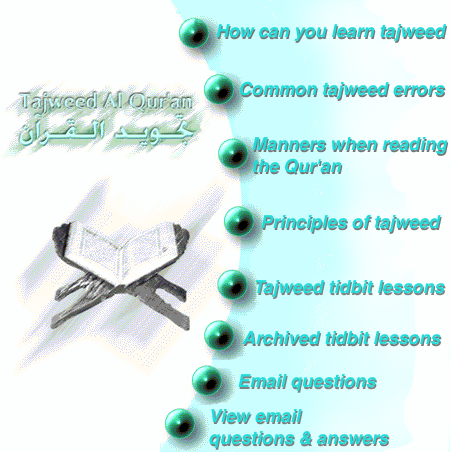|
|

copyright © 2002, abouttajweed.com, all rights reserved |
Common Tajweed MistakesThe
two most common tajweed mistakes made by non-Arabs are the timings of the
vowels, and medd letters, and in the articulation points of the letters.
The first type of mistake has been addressed in the first of what will
be, insha’ Allah many tidbits; please see the tidbit lesson link.
The second type of mistake, that in the letters themselves, is a major
problem that needs to be addressed by all non-Arabs, whether they are
Westerners, Europeans, Africans, from the Indo Pakistani subcontinent, or from
Eastern Asia. At the outset, the
letters that occur in Arabic that are not common in other languages would be
what one would imagine to be a problem, but in fact, there are letters in Arabic
that are similar to other languages, but do not share the same articulation
points with their counterparts. The
letters that occur in Arabic, that are not common in other languages are:
The
articulation points of all the Arabic letters will be described later,
insha’Allah in a future tidbit lesson. Letters
that have similar sounds in other languages, but in fact have different
articulation points are:
The
first two
(starting
from the right), use the tip of the tongue from the top side and what lies
opposite from the tip of the tongue from the gum line of the two top front
incisors. Many different languages
have similar letters, as in English there is “d” and “t”, but they
articulate these letters at a posterior position in the mouth from what the
Arabs use as an articulation point. The
result is an incorrect pronunciation of these letters when reading Qur’an. The
next two letters also are used in other languages.
Most notably the kaf in Arabic is similar to the “k” in English.
Many languages pronounce this letter farther back in the mouth than the
correct Arabic position. The deep
part of the tongue meets up with the hard palate in Arabic to pronounce this
letter, not the soft palate, as many mistakenly use. The
ra’ and lam are two letters that non-Arabs have some difficulty in pronouncing
correctly. The ra’ uses the tip
of the tongue and the top of the tip and the gums of the two top incisors, but
the trick to the ra’ is actually hitting the gum.
Many Muslims try to pronounce the ra’ without touching the tongue to
the gum. Some mistakenly use the
throat, like the French do in the French “r”.
The Arabic lam has the widest use of the tongue of any other letters, but
uses only the end of the sides of the tongue until it ends at the tip, which
then hits the gums of the front upper eight teeth. The
above are just brief summaries of the letters, and as stated before, insha’
Allah soon a tidbit lesson will be posted with all the articulation points
discussed in detail. A
third mistake incurred by Arabs and non-Arabs alike is in making proper stops
and starts. There is more than one
aspect to this mistake. The first aspect is that the proper way to stop on a word is
by putting a sukoon, or absence of a vowel on the last letter of the word.
It is not allowed to stop using the harakah, or vowel on the last letter
of the word. The second aspect of
stopping is that of stopping at a place that doesn’t contradict the meaning
intended by Allah, the Exalted. The
same mistake can occur when starting up after stopping and taking a breath.
One cannot just start on the next word arbitrarily, instead the meaning
needs to be considered, and the start should be on a word that portrays the
correct and complete meaning, even if the reciter needs to go back two or three
words. The stop and start will be
explained in detail, insha’ Allah in future tidbit lessons.
One
note that is of utmost importance. It
is vital that the Muslim learn the Arabic letters and vowels and recite the
Qur’an using them, NOT a transliteration.
Transliterations do not take into account the various letters that sound
similar to the untrained ear, but are very different in pronunciation.
The Qur’an is the word of Allah, revealed to man as a guidance, and we
have to be extremely careful to read it, as best we can, with proper pronunciation.
Reading a transliteration can lead to changing the meaning of the Arabic
Qur’an by mispronouncing letters. |